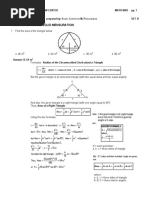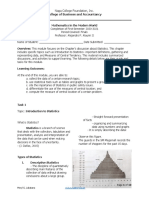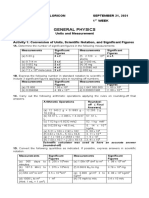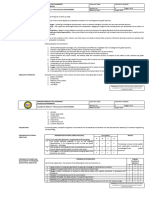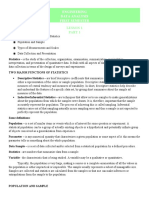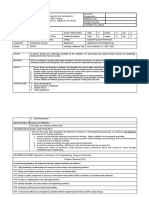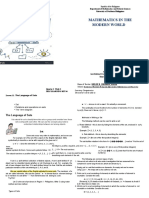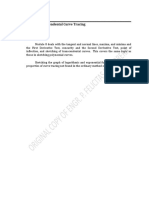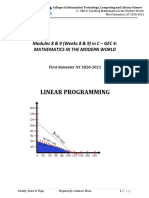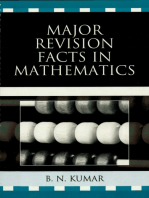Engineering Calculus 1 Module 1 Functions
Uploaded by
jilynlevvantinoEngineering Calculus 1 Module 1 Functions
Uploaded by
jilynlevvantinoMODULE NO.
1 – FUNCTIONS
FUNCTIONS
Let’s say that two variables x and y are related so that the value of one variable
determines the value of the other variable. For example, for every value of x there is
a corresponding value of y. So, the value of y depends on the value of x. Then, we
can say that y is the dependent variable while x is the independent variable.
If y is the dependent variable and x is the independent variable, then, “y is the
function of x “ given by the symbol y = f(x).
Maybe y is dependent of two variables say x and z. Then, y is a function of x and z.
Therefore, a function f is a relationship or expression involving one or more
variables.
A function maybe explicit or implicit. Explicit function is a function that is very
clear and stated plainly, while implicit function is a function that is understood but
not described clearly or plainly. Let’s take a look of the following two expressions:
1. y = 4x + 3
2. 3x + y = 22
In expression 1, it is clearly described that y is a function of one variable which is x.
In expression 2, we clearly understood that “3x plus y equals 22” but we do not
know which variable is a function of the other variable.
Therefore, we can say that expression 1 is an example of an explicit function, while,
expression 2 is an example of an implicit function.
However, in expression 2 (i.e. 3x + y = 22), if we are going to solve y in terms of x,
then we need to transpose 3x to the right side of the equal (=) sign leaving only y
to the left side of the equal sign. Then, expression 2 (if we are going to solve for y)
will become y = 22 – 3x which is now an explicit function [y = f(x)]
On the other hand, in expression 2, if we solve x in terms of y, then we can write,
22 – y
x= [now x is a function of y, x = f(y) ]
3
DIFFERENTIAL CALCULUS ENGR. R.G. BRASOS
MODULE NO. 1 – FUNCTIONS
GRAPH OF A FUNCTION
A graph is a pictorial representation or a diagram representing data or values. It is a
set of point in the plane that corresponds to the ordered pairs of a relation or
expression.
In the given relation or expression, y = x +1, for every real value of x, there is a
corresponding real value of y. The tabulated numbers below show that given the
value of x, the value of y is calculated using the given relation.
Variable A B C D E F
x -2 -1 0 1 2 3
y -1 0 1 2 3 4
The table above shows 6 ordered pairs : A(-2, -1), B(-1, 0), C(0, 1), D(1, 2), E(2,
3) and F(3,4). The real values of x (-2, -1, 0, 1, 2, 3) are the domain, and the real
values of y (-1, 0, 1, 2, 3, 4) are the range.
The domain of a relation is the complete set of possible values of the independent
variable x which will output real y-values. It is the set of first coordinates of the
ordered pairs and range is the set of second coordinates of the ordered pairs.
Domain : {-2, -1, 0, 1, 2, 3}
Range : {-1, 0, 1, 2, 3, 4}
The graph of the function is illustrated below:
y
F
4
3
E
D
2
1 C
B
x
-4 -3 1 2 3 4
A-2 -1
-2
-3
DIFFERENTIAL CALCULUS ENGR. R.G. BRASOS
MODULE NO. 1 – FUNCTIONS
The graph is a straight line
Sample Problem No. 1:
Determine the domain and range of the expression x = y2. Sketch the graph.
Solution:
The expression can be re-written as y = ±√𝑥 . For every value of x, there are 2
values of y. Assuming some values of x, the values of y are determined.
x 0 1 2 3
y 0 ±1 ±1.41 ±1.73
x
-4 -3 -1 1 2 3 4
-2
-3
The graph is a parabola
===================================================
Assignment No. 1
a) Determine the domain and range of the set of points at sketch or plot the set
of points.
A = {(-4, -2), (-3, -1), (0, 0), (1, 1), (2, -2), (3, 3), (4, -2), (3, 1)}
DIFFERENTIAL CALCULUS ENGR. R.G. BRASOS
MODULE NO. 1 – FUNCTIONS
b) Assume the domain and determine the range of the given relation and sketch
the graph.
2x – 3y = 6
===================================================
THE LINEAR FUNCTION
The simplest type of a function is a linear function in which the graph is a line.
We need only 2 ordered pairs to sketch the graph (as we remember that 2 points
determine a line). In mathematics, when a “line” is mentioned, it means a straight
line, otherwise, it is a curve.
Any equation or expression in the form of
y = mx + b
is called a linear function, where m is the slope of the line and b is the y-intercept.
Given a line y = 3x – 2, it is clearly given that the slope m = 3 and the y-intercept
is -2. To sketch the graph, assume values of x and calculate y.
x 0 2
y -2 4
4
y =3x - 2
3
x
-4 -3 -1 1 2 3 4
-2
-3
y-intercept = -2
DIFFERENTIAL CALCULUS ENGR. R.G. BRASOS
MODULE NO. 1 – FUNCTIONS
THE QUADRATIC FUNCTION
Any equation in the form
y = ax2 +bx + c (a, b, & c are constants and a ≠ 0)
The quadratic equation is a parabola. The following are examples of the equation:
1. y = 2x2 + 3x + 5
2. y = x2 + 2x - 3
3. y = -x2 - x
4. y = -2x2
5. y = 5x2
To sketch the parabola, assume at least values of x (positive & negative) and solve
for y.
The following are also quadratic equations and the sketch is a parabola:
1. x = 2y2 + 3y + 5
2. x = y2 + 2y - 3
3. x = -y2 - y
4. x = -2y2
5. x = 5y2
The difference between the first set and the second set is the opening of the
parabola.
y y
First Set:
x or x
DIFFERENTIAL CALCULUS ENGR. R.G. BRASOS
MODULE NO. 1 – FUNCTIONS
vertex
vertex
Second Set:
y y
vertex vertex
or
THE CUBIC FUNCTION
Any equation in the form
y = ax3 +bx2 + cx + d (a, b, c & d are constants and a ≠ 0)
Sketch the expressions y = x3 and y = 1 – x3
For y = x3 :
x 0 1 -1 2 -2
y 0 1 -1 8 -8
Intercept at (0,0)
1
DIFFERENTIAL CALCULUS ENGR. R.G. BRASOS
MODULE NO. 1 – FUNCTIONS
-2 -1 1 2
-1
-2
-8
For y = 1 - x3 :
x 0 1 -1 2 -2
y 1 0 2 -7 7
y-intercept = 1
1
-2 -1 1 2
-1
x-intercept = 1
-2
-7
Points of interception: (0,1) and (1,0)
THE RATIONAL FUNCTION
Any function defined by
p(x)
f(x) = , q(x) ≠ 0
q(x)
A rational function has a graph with one or more breaks.
DIFFERENTIAL CALCULUS ENGR. R.G. BRASOS
MODULE NO. 1 – FUNCTIONS
===================================================
Assignment No. 2
1. Sketch the graph of the following and determine the point of interception.
a) f(x) = 3x – 1
b) f(x) = x2 – 2
c) f(x) = x3 + 2
===================================================
APPLICATION OF FUNCTIONS:
In this section, we will use functional notations to represent and solve some
problems.
Sample Problem No. 2:
The sum of two positive numbers is 100. Let one of the numbers be x and express
the product P of the two numbers as a function of x.
Solution:
Let x = the first number
100 – x = the second number
P = the product of the two numbers in terms of x
Therefore,
P = (first number)(second number)
= (x)(100-x)
P = 100x – x2
Sample Problem No. 3:
A rectangle has a perimeter of 10 meters. Express the area A of the rectangle as a
function of the width x.
Solution:
Perimeter = 10 meters
A = area as a function of x
DIFFERENTIAL CALCULUS ENGR. R.G. BRASOS
MODULE NO. 1 – FUNCTIONS
The figure is
Width x
Length y
Perimeter = 2x + 2y
A = xy
The perimeter = 10, then
10 = 2x + 2y
2y = 10 – 2x
y=5-x
Therefore for A,
A = x(5-x)
===================================================
Assignment No. 3:
a) The area A of a circle is the product of the square of the radius r and pi (A =
πr2), while the circumference C is the product of pi and twice the radius r (C
= 2πr). Express the area A as function of its circumference C.
b) The product of two numbers is 50. Assume one number is x. Express the sum
of the two numbers in terms of x.
===================================================
DIFFERENTIAL CALCULUS ENGR. R.G. BRASOS
You might also like
- Time-Rates: Page - Differential Calculus Engr. Alberto F. ServitoNo ratings yetTime-Rates: Page - Differential Calculus Engr. Alberto F. Servito11 pages
- Chapter 2 in Mathematics in The Modern World100% (2)Chapter 2 in Mathematics in The Modern World5 pages
- Mathematical Language and Symbols: LESSON 2.1: Mathematics As A LanguageNo ratings yetMathematical Language and Symbols: LESSON 2.1: Mathematics As A Language5 pages
- MODULE 1 Mathematics in The Modern World GNED 03 BSCPE & BSEE 101No ratings yetMODULE 1 Mathematics in The Modern World GNED 03 BSCPE & BSEE 10114 pages
- Mathematics in The Modern World: Number Sequence and SeriesNo ratings yetMathematics in The Modern World: Number Sequence and Series12 pages
- Mathematics in The Modern World Chapter 4-Data-Management0% (1)Mathematics in The Modern World Chapter 4-Data-Management41 pages
- JCSF - Mathematics - Trigonometry & Solid Mensuration With SolutionsNo ratings yetJCSF - Mathematics - Trigonometry & Solid Mensuration With Solutions30 pages
- Module 1-Mathematics As A Language: Maribel D. Cariñ0100% (1)Module 1-Mathematics As A Language: Maribel D. Cariñ04 pages
- Module 6. Differentiation of Transcendental FuntionsNo ratings yetModule 6. Differentiation of Transcendental Funtions23 pages
- General Physics: Andrie Jacob G. Doloricon SEPTEMBER 21, 2021 Grade Xii - Stem D 1 WeekNo ratings yetGeneral Physics: Andrie Jacob G. Doloricon SEPTEMBER 21, 2021 Grade Xii - Stem D 1 Week6 pages
- MMW Module 4.1 - Statistics - Measure of Central Tendency100% (1)MMW Module 4.1 - Statistics - Measure of Central Tendency3 pages
- BSIT 1A Learning Material No. 3 Problem Solving and Reasoning ANSWERNo ratings yetBSIT 1A Learning Material No. 3 Problem Solving and Reasoning ANSWER17 pages
- Solutions To Scalar and Vector ProblemsNo ratings yetSolutions To Scalar and Vector Problems30 pages
- Solutions To Calculus by Feliciano and Uy Chapter 1 2 3100% (2)Solutions To Calculus by Feliciano and Uy Chapter 1 2 337 pages
- Lesson 1: Engineering Data Analysis First Semester - A.Y. 2021 - 2022No ratings yetLesson 1: Engineering Data Analysis First Semester - A.Y. 2021 - 20224 pages
- Chapter 6: CODES: Learner'S Module: Mathematics in The Modern World100% (3)Chapter 6: CODES: Learner'S Module: Mathematics in The Modern World6 pages
- Activity I For GED 141 Mathematics in The Modern WorldNo ratings yetActivity I For GED 141 Mathematics in The Modern World4 pages
- Lesson 3 Elementary Logic: Connectives, Variables, Quantifiers, and NegationNo ratings yetLesson 3 Elementary Logic: Connectives, Variables, Quantifiers, and Negation5 pages
- Learning Module 1 For Mathematics in The Modern WorldNo ratings yetLearning Module 1 For Mathematics in The Modern World9 pages
- 2021 Module 2 - Mathematical Language and SymbolsNo ratings yet2021 Module 2 - Mathematical Language and Symbols34 pages
- Mathematics in The Modern World: Binary OperationNo ratings yetMathematics in The Modern World: Binary Operation11 pages
- Differential and Integral Calculus by Feliciano and Uy100% (1)Differential and Integral Calculus by Feliciano and Uy53 pages
- MMW Chapter 3 Problem Solving and Reasoning100% (2)MMW Chapter 3 Problem Solving and Reasoning27 pages
- Mathematics in The Modern World-Module 5No ratings yetMathematics in The Modern World-Module 569 pages
- Mathematics in The Modern World Chapter 1 3No ratings yetMathematics in The Modern World Chapter 1 332 pages
- The Strategies Used Were Logical Reasoning and Finding Pattern0% (1)The Strategies Used Were Logical Reasoning and Finding Pattern10 pages
- AA314 Handout 1 Equation of A Line in 2D3DNo ratings yetAA314 Handout 1 Equation of A Line in 2D3D2 pages
- Day 01 - Relations and The Coordinate System (1-6)No ratings yetDay 01 - Relations and The Coordinate System (1-6)20 pages
- ECE 340 Lecture 26: Reverse Bias Breakdown: Class OutlineNo ratings yetECE 340 Lecture 26: Reverse Bias Breakdown: Class Outline20 pages
- Anodic Dissolution of Pure Aluminum During Electrocoagulation Process - Influence of Supporting Electrolyte, Initial PH, and Current Density PDF100% (1)Anodic Dissolution of Pure Aluminum During Electrocoagulation Process - Influence of Supporting Electrolyte, Initial PH, and Current Density PDF12 pages
- Manual Acrylite Injection Molding Brochure100% (1)Manual Acrylite Injection Molding Brochure36 pages
- Predicting Crystallite Size of Mg-Ti-SiC Nanocomposites Using An Adaptive Neuro-Fuzzy Inference System Model Modified by Termite Life Cycle OptimizerNo ratings yetPredicting Crystallite Size of Mg-Ti-SiC Nanocomposites Using An Adaptive Neuro-Fuzzy Inference System Model Modified by Termite Life Cycle Optimizer16 pages
- ECE Renewable Energy Technology SyllabusNo ratings yetECE Renewable Energy Technology Syllabus5 pages
- Student Exploration: Distance-Time and Velocity-Time GraphsNo ratings yetStudent Exploration: Distance-Time and Velocity-Time Graphs7 pages
- McCool-DEVELOPMENT OF A PLUG ASSISTED THERMOFROMING SIMULATION-PaperNo ratings yetMcCool-DEVELOPMENT OF A PLUG ASSISTED THERMOFROMING SIMULATION-Paper4 pages
- Time-Rates: Page - Differential Calculus Engr. Alberto F. ServitoTime-Rates: Page - Differential Calculus Engr. Alberto F. Servito
- Mathematical Language and Symbols: LESSON 2.1: Mathematics As A LanguageMathematical Language and Symbols: LESSON 2.1: Mathematics As A Language
- MODULE 1 Mathematics in The Modern World GNED 03 BSCPE & BSEE 101MODULE 1 Mathematics in The Modern World GNED 03 BSCPE & BSEE 101
- Mathematics in The Modern World: Number Sequence and SeriesMathematics in The Modern World: Number Sequence and Series
- Mathematics in The Modern World Chapter 4-Data-ManagementMathematics in The Modern World Chapter 4-Data-Management
- JCSF - Mathematics - Trigonometry & Solid Mensuration With SolutionsJCSF - Mathematics - Trigonometry & Solid Mensuration With Solutions
- Module 1-Mathematics As A Language: Maribel D. Cariñ0Module 1-Mathematics As A Language: Maribel D. Cariñ0
- Module 6. Differentiation of Transcendental FuntionsModule 6. Differentiation of Transcendental Funtions
- General Physics: Andrie Jacob G. Doloricon SEPTEMBER 21, 2021 Grade Xii - Stem D 1 WeekGeneral Physics: Andrie Jacob G. Doloricon SEPTEMBER 21, 2021 Grade Xii - Stem D 1 Week
- MMW Module 4.1 - Statistics - Measure of Central TendencyMMW Module 4.1 - Statistics - Measure of Central Tendency
- BSIT 1A Learning Material No. 3 Problem Solving and Reasoning ANSWERBSIT 1A Learning Material No. 3 Problem Solving and Reasoning ANSWER
- Solutions To Calculus by Feliciano and Uy Chapter 1 2 3Solutions To Calculus by Feliciano and Uy Chapter 1 2 3
- Lesson 1: Engineering Data Analysis First Semester - A.Y. 2021 - 2022Lesson 1: Engineering Data Analysis First Semester - A.Y. 2021 - 2022
- Chapter 6: CODES: Learner'S Module: Mathematics in The Modern WorldChapter 6: CODES: Learner'S Module: Mathematics in The Modern World
- Activity I For GED 141 Mathematics in The Modern WorldActivity I For GED 141 Mathematics in The Modern World
- Lesson 3 Elementary Logic: Connectives, Variables, Quantifiers, and NegationLesson 3 Elementary Logic: Connectives, Variables, Quantifiers, and Negation
- Learning Module 1 For Mathematics in The Modern WorldLearning Module 1 For Mathematics in The Modern World
- Differential and Integral Calculus by Feliciano and UyDifferential and Integral Calculus by Feliciano and Uy
- The Strategies Used Were Logical Reasoning and Finding PatternThe Strategies Used Were Logical Reasoning and Finding Pattern
- Day 01 - Relations and The Coordinate System (1-6)Day 01 - Relations and The Coordinate System (1-6)
- ECE 340 Lecture 26: Reverse Bias Breakdown: Class OutlineECE 340 Lecture 26: Reverse Bias Breakdown: Class Outline
- Anodic Dissolution of Pure Aluminum During Electrocoagulation Process - Influence of Supporting Electrolyte, Initial PH, and Current Density PDFAnodic Dissolution of Pure Aluminum During Electrocoagulation Process - Influence of Supporting Electrolyte, Initial PH, and Current Density PDF
- Predicting Crystallite Size of Mg-Ti-SiC Nanocomposites Using An Adaptive Neuro-Fuzzy Inference System Model Modified by Termite Life Cycle OptimizerPredicting Crystallite Size of Mg-Ti-SiC Nanocomposites Using An Adaptive Neuro-Fuzzy Inference System Model Modified by Termite Life Cycle Optimizer
- Student Exploration: Distance-Time and Velocity-Time GraphsStudent Exploration: Distance-Time and Velocity-Time Graphs
- McCool-DEVELOPMENT OF A PLUG ASSISTED THERMOFROMING SIMULATION-PaperMcCool-DEVELOPMENT OF A PLUG ASSISTED THERMOFROMING SIMULATION-Paper


















